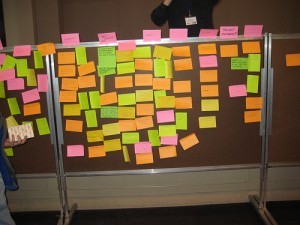 One area in which Lean can advantage companies of all sizes, across nearly all industries, is project management. Although sometimes characterized more by buzzwords than action, project management done right is an enormous boon to any company working to move forward.
One area in which Lean can advantage companies of all sizes, across nearly all industries, is project management. Although sometimes characterized more by buzzwords than action, project management done right is an enormous boon to any company working to move forward.
Four Ways to Apply Lean Principles to Project Management
Apply Continuous Improvement to Project Management
Kaizen (continuous improvement) is directly applicable to project management. For instance, consider a project manager who manages advertising campaigns. Key Performance Indicators (KPIs) could include completion time; project cost; time one team spent waiting while another project component awaited completion; number of revisions; product sales; and many, many more. Continuous improvement relies on KPIs to determine success, making project management an excellent fit for Kaizen.
Address All "Customers'" Definitions of Value
Imagine that you are managing a software development project. Who are your customers? Naturally, your mind will leap to software buyers, but do not stop there. Your marketing team is also a "customer," awaiting a product whose key value to them will be its marketability. What about your customer support department? Might not they be customers also, awaiting a bug-free product that allows for efficient service?
Project managers should think ahead to the needs of customers within their organization and outside it. Address internal "customers'" definitions of value, while still allowing the ultimate customers--those who will buy the product--to contribute to its outcome.
Combine Value Stream Mapping with a Work Breakdown Structure
In project management, a Work Breakdown Structure (WBS) is the roadmap that sets out a clear path from start to finish, breaking down labor elements in a tree structure which starts from the final objective and moves backwards. In Lean management, a value stream map is a road map starting with raw materials and leading to value landing in the hands of an end user or customer.
Combine these two valuable visualization tools to gain new perspective on project management. Maybe you will discover that your work breakdown structure calls for the duplication of work, or that your value stream map demonstrates that too many resources are spent on transportation and travel in order to complete projects. Mapping both value and work will lead you to a deeper level of understanding.
Lean Project Prioritization
Project management calls for the division of projects in three categories: Compliance, operations, and strategic projects are all critical to business success. It is easy to become bogged down in compliance projects (those you must do or face serious penalties) and operations projects (the day-to-day projects allowing you to continue doing business) and forget about strategy.
Use Lean management to prioritize projects based on customer-defined value, shifting resources as necessary to ensure that compliance projects are completed in order to avoid severe consequences. Strive to streamline operations projects by finding efficiencies and eliminating waste. Then, add strategic projects to your team's workload over time, creating the vision and momentum needed to deliver ongoing value to customers as you grow.
